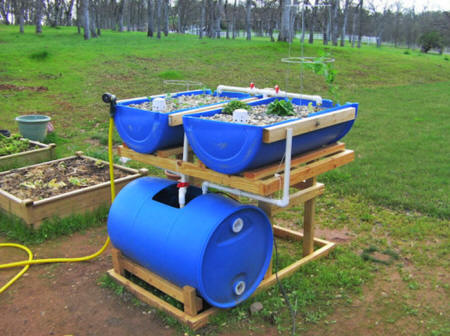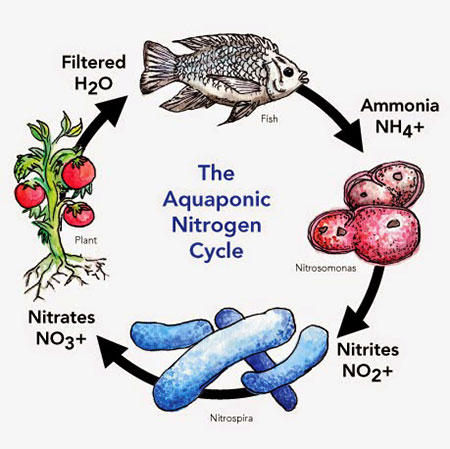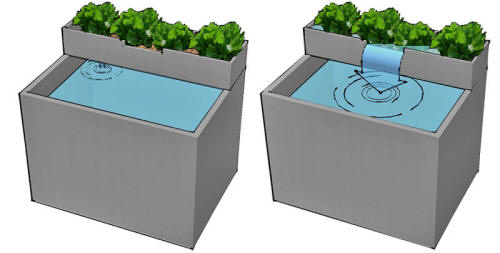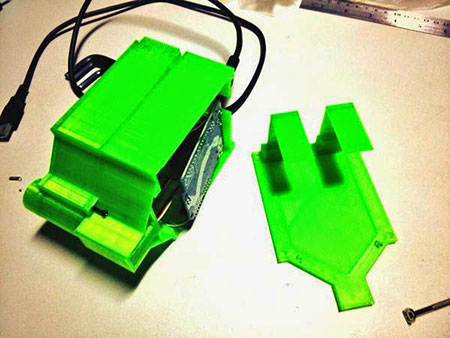|
Aquaponics
Aquaponics is a combination of fish farming (aquaculture) and soilless agriculture (hydroponics).
Fish are kept in a water tank, and above it is a
growing bed. Water from the fish tank is pumped up to the growing
bed where it filters through a growing medium and the roots of your
plants, then back into the fish tank below.
This guide hopes to shed some light on a few of them.
You have your fish tank, you have your plants.
Next, you must wait patiently for two things.
Once it begins, you will see your fish and plants begin to thrive.
But before that, you may see disappointing results, including the loss of fish and droopy looking, sickly plants. Knowing that there is light at the end of the tunnel can help beginners hang in there and keep going.
What patiently for the necessary microbiological
activity to take root in your system and you will be rewarded.
Your water pump is the heart of your aquaponics system.
Without it, the water will become stagnant, your plants will dry out and die, and the entire system will collapse. The tube you use to take water from your fish tank to your grow bed is very important. Make sure that it is secure and cannot under any conceivable circumstance come loose and fall out of your grow bed.
If this happens, your system will empty out onto the
floor, your fish will die, your plants will shrivel, and your water
pump may burn out.
Another common problem, particularly in mature systems, is your grow bed's return drain becoming blocked.
This can happen because your growing medium obstructs your drain outlet for whatever reason, or when roots become well developed to the point where they are blocking your system's drain.
This system's grow bed has an overflow notch designed into it (left). If for whatever reason your normal drainage stops, water will overflow through this notch (right), safely back into your fish tank until you unblock your drain. Without such a notch, water will flow out in all directions, including onto the floor, eventually emptying out your entire system!
When drain blockage happens, water will backup in the grow bed and flow out wherever the path of least resistance so happens to be.
Once again, your project may empty out onto the
floor, with similarly disappointing consequences.
You must devise an overflow system best suited to the
growing medium you are using.
Little is needed day-to-day to take care of an aquaponics system once the fish are settled and plants are growing.
Fish must be feed once or twice a day depending on the species, and once a week or so, water may be added as needed. It is possible to feed your fish automatically, meaning that only topping off the tank once in a while will be necessary.
If your plants are not exposed to direct sunlight, you may use artificial lighting set on a timer such as off-the-shelf LED floodlights (30-50W, 6500K). Timers, plugs, and outlets should be kept above the water level in both your fish tank and your growing bed (including in case of a possible overflow incident).
Plugs and outlets should be kept so that if they fell they would not plunge into your system.
A 3D printed, Arduino-driven
Despite whatever level you automate your system to, it is still a good idea to check it as often as you can, including checking drain outlets and the health of your plants and fish.
Remote monitoring systems, where you can check in on your
project over the Internet using a webcam, are also options you can
include with your aquaponics system, but are still not substitutes
for a first-hand assessment.
The temptation to start big should be resisted.
Start a small system and meet all of your goals with it first such as raising fish to a certain size and number as well as raising plants to the point where they bear fruit or produce vegetables suitable for harvesting and use.
Once this is accomplished, then move on to larger,
more challenging systems.
Starting on a larger system and running into failures
and setbacks will require larger amounts of time, money, and
resources to correct and overcome.
Failure is nothing more than a challenge to reassess what you have done, what mistakes you might have made, and what improvements you need to make in order to successfully cultivate an aquaponics system.
Find success stories that mirror approximately the
same sort of set up you are thinking about and use that as
encouragement to reach your goals, then exceed them.
Once you've succeeded, feel free to share your experience with others.
|




